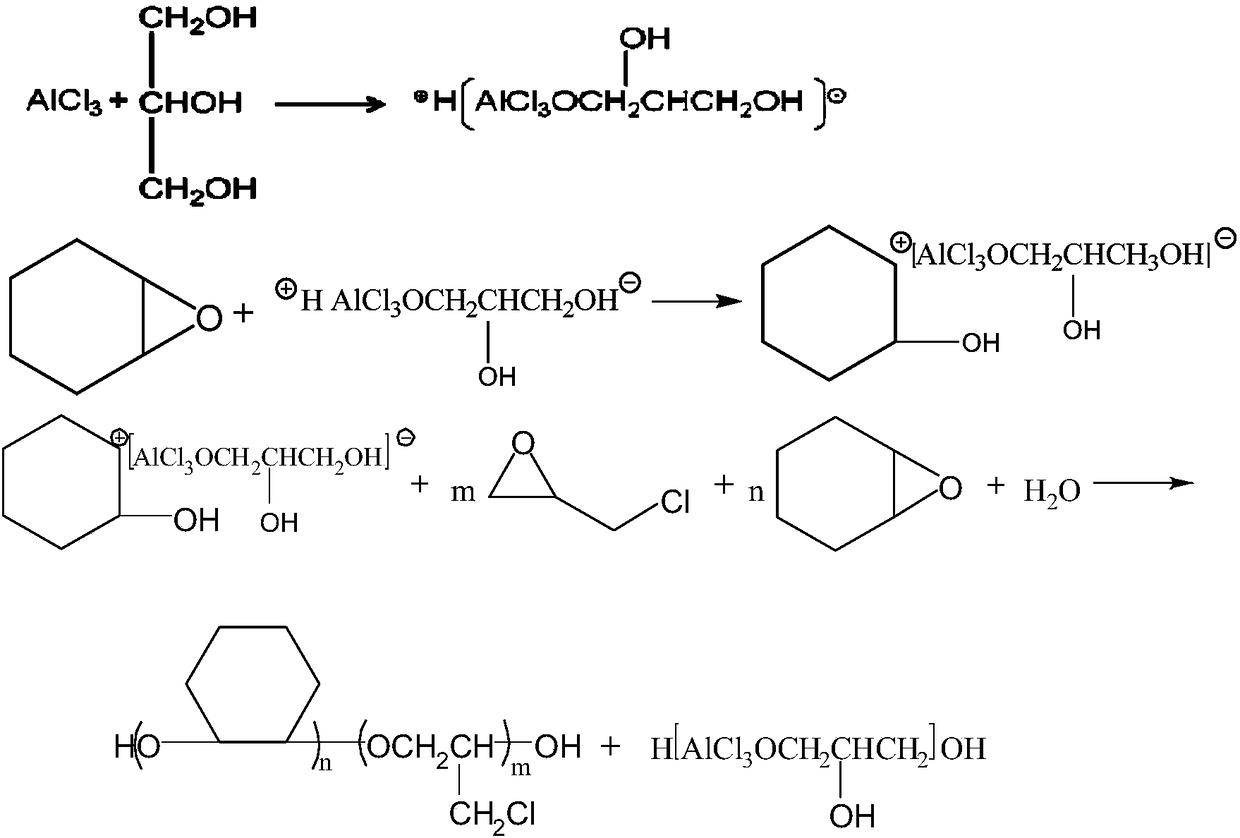Synthesis method of hydroxyl terminated polyether for cultural relic adhesive
A technology of hydroxyl-terminated polyether and synthesis method, applied in the direction of polyurea/polyurethane coatings, coatings, etc., can solve the problems of difficult catalyst recovery, environmental pollution, toxic substances, etc., and achieves rich raw materials, good effects, and easy production and preparation. Effect
- Summary
- Abstract
- Description
- Claims
- Application Information
AI Technical Summary
Problems solved by technology
Method used
Image
Examples
Embodiment 1
[0008] Embodiment 1: A method for synthesizing a hydroxyl-terminated polyether used as an adhesive for cultural relics according to the present invention. Specifically, 5 g of loaded anhydrous aluminum chloride catalyst is weighed and added to a three-necked flask, and then 20 ml of dihydrogen chloride is added to the flask. Chloromethane solvent, place the three-necked flask in a low-temperature liquid circulation pump, when the temperature drops below 5°C, add 40ml of cyclohexane epoxy into the three-necked flask dropwise, after the addition is complete, add 1g of chain extender to the three-necked flask Glycerol, the reaction temperature is 10°C, react for 3 hours, add 20ml of distilled water into the three-necked flask, stop the reaction, wash, and distill under reduced pressure to obtain the homopolyether of hydroxyl-terminated polyether.
Embodiment 2
[0009] Embodiment 2: A method for synthesizing a hydroxyl-terminated polyether used as an adhesive for cultural relics according to the present invention, specifically, take 8g of loaded anhydrous aluminum chloride catalyst, add it to a three-necked flask, and then add 25ml dihydrogen chloride to the flask. Chloromethane solvent, place the three-necked flask in the low-temperature liquid circulation pump, when the temperature drops below 5°C, add 50ml of the mixed solution of epoxycyclohexane and tetrahydrofuran in a molar ratio of 1:1 into the three-necked flask dropwise, After the dropwise addition, add 2g of chain extender glycerol to the three-necked flask, and react at 15°C for 8 hours. Add 20ml of distilled water to the three-necked flask to terminate the reaction, wash, and distill under reduced pressure to obtain the ring of hydroxyl-terminated polyether. Oxycyclohexane-tetrahydrofuran copolyether.
Embodiment 3
[0010] Embodiment 3: A method for synthesizing a hydroxyl-terminated polyether used as an adhesive for cultural relics according to the present invention. Specifically, 10 g of loaded anhydrous aluminum chloride catalyst is weighed and added to a three-necked flask, and then 30 ml of dihydrogen chloride is added to the flask. Chloromethane solvent, place the three-necked flask in a low-temperature liquid circulation pump, and when the temperature drops below 5°C, add 60ml of a mixed solution of epoxycyclohexane and epichlorohydrin at a molar ratio of 1:1 to the three-necked flask dropwise. In the flask, after the dropwise addition, add 4g of chain extender glycerin into the three-necked flask, react at 20°C, react for 12h, add 20ml of distilled water into the three-necked flask, terminate the reaction, wash, and distill under reduced pressure to obtain hydroxyl-terminated poly Ether epoxy cyclohexane - epichlorohydrin copolyether.
[0011] Taking epichlorohydrin as an example,...
PUM
| Property | Measurement | Unit |
|---|---|---|
| tensile properties | aaaaa | aaaaa |
| transmittivity | aaaaa | aaaaa |
| Shore hardness | aaaaa | aaaaa |
Abstract
Description
Claims
Application Information
 Login to View More
Login to View More - R&D
- Intellectual Property
- Life Sciences
- Materials
- Tech Scout
- Unparalleled Data Quality
- Higher Quality Content
- 60% Fewer Hallucinations
Browse by: Latest US Patents, China's latest patents, Technical Efficacy Thesaurus, Application Domain, Technology Topic, Popular Technical Reports.
© 2025 PatSnap. All rights reserved.Legal|Privacy policy|Modern Slavery Act Transparency Statement|Sitemap|About US| Contact US: help@patsnap.com


